Plastic ZIL-135B and a boat on wheels
MVTU them. Bauman hurries to the rescue
В one of the previous parts The cycle on the development and development of ZIL-135 family machines was a reference to the amphibian with the “B” index, which Vitaly Grachev, head of the ZIL design bureau, built for rocket launchers. It is on the basis of this machine Zilovtsy together with scientists and engineers MVTU them. In the early 60s, Bauman tried to build an amphibian with a plastic carrier. Even now, creating such a thing is a non-trivial task, and 60 years ago it was revolutionary. And, of course, secretly. Information on the work on the plastic supporting body of the 135th series is not even in the well-known book “Overcoming off-road. Developments of SKB ZIL ”. Just a mention of the ZIL-5B frame with a fiberglass body built on July 1962, 135. According to the authors of the book, on July 24 of the same year, a four-wheeled amphibian was tested on a reservoir in Bronnitsy. At the same time, in 1965, an article by engineers V. S. Tsybin and A. G. Kuznetsov, dedicated to amphibians with a plastic carrier body, was published in the profile and secret (for its time) magazine “Bulletin of Armored vehicles”. I repeat, with a supporting body, that is, deprived of a frame. Subsequently, Professor Tsybin will become one of the founders of the domestic system for designing and creating elements of wheeled vehicles from composite polymer materials. The work was carried out at the SM-10 “Wheeled Machines” department, which since 1953 was led by the famous automobile engineer, chief designer of the Gorky Automobile Plant Andrei Aleksandrovich Lipgart.
The choice in favor of a completely plastic body for ZIL-135B was made due to the heavy weight of the original steel machine. As you know, with the Luna rocket the four-wheeled vehicle couldn’t float normally and once in the tests almost went to the bottom. Therefore, Vitaly Grachev did not just try to sheathe amphibian plastic panels, but completely replace the metal in the structure with lightweight material. At ZIL they did not know how to do this, and therefore they turned for help to MVTU im. Bauman.
One of the advantages of an all-plastic body was the reduction in machine weight: a material with high strength characteristics had a low specific gravity. In addition, there is the possibility of manufacturing monolithic (seamless) body structures of any complexity and configuration with minimal costs for tooling and equipment. Traditional sheet steel did not allow simple and inexpensive to make body streamlined. Plastic technologies increased the corrosion resistance of the structure, reduced operating and maintenance costs, and also facilitated repairs. Researchers from MVTU noted among the pluses the almost complete absence of leakage with a bullet lumbago of the case and the possibility of staining the material in bulk. Among the obvious disadvantages are high creep under long-term loads, relatively high cost, low rigidity and low long-term heat resistance.
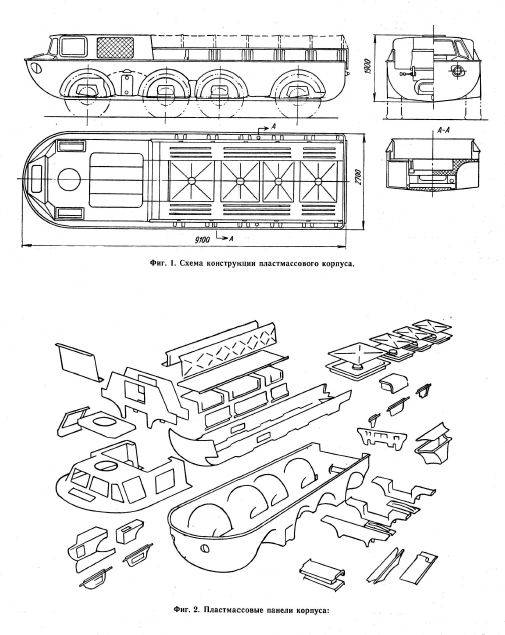
[Center]Design scheme ZIL-135B with a plastic carrier. Source: "Bulletin of armored vehicles"
The base ZIL-135B was a frame machine without suspension, which seriously increased the load on the body in motion. In this case, the engineers could not change anything in the layout, otherwise it would lead to a complete reformatting of the design of the future missile carrier. The practice of copying the sizes and shapes of metal parts did not allow making units similar in properties: plastic did not possess the necessary rigidity. Three-layer elements made of fiberglass, polystyrene and glue were chosen as the base material at MSTU. They did not completely abandon the metal. Steel were kilson (longitudinal power element of the hull-boat), braces of the towing device, edging of the hull and sides, instrument panel, brackets for fastening the power units, drain plugs and wheel niche inserts.
The main supporting system is an external monolithic panel, into which an internal panel with amplifiers and cross-pieces between wheel niches is inserted. The space between the panels is filled with polystyrene with a specific gravity of 0,1-0,15 g / cm3. On the power elements of the supporting body hereinafter:
The case was built of panels with a thickness of 2 to 8 mm, interconnected with epoxy glue, as well as bolts, rivets and screws. The main body material was fiberglass, consisting of PN-1 polyester resin and TZhS-0,8 fiberglass tow. The largest panel weighing 900 kilograms and a thickness of 8 mm was molded by the contact method on a wooden mold. About 280 man-hours were spent on this.
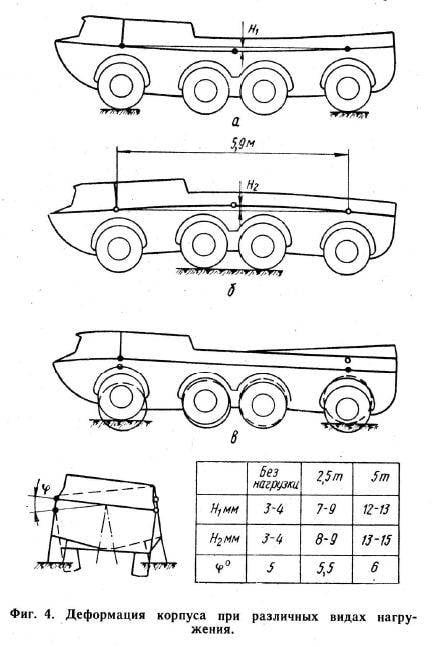
When the plastic ZIL-135B assembled using the new technology was put on the scales, it turned out that the designers won a whole ton of amphibian weight. This is about 10% of the weight of steel ZIL. Further, the prototype had dynamic tests on the highway, in rough terrain, in a country road with an empty body, with full and half load. The lack of suspension played a cruel joke here - it cut the material under the wheel brackets. High thermal loading of the motor compartment led to the destruction of amplifiers near the motor. Tests were also conducted on the bench in order to determine the static deformation of the body under load. It turned out that the body is bent, but, in comparison with steel, slightly. When an experienced amphibious all-terrain vehicle ran 10 thousand kilometers, it was dismantled. The power elements between the 1st and 2nd axis were destroyed due to the thermal influence of the motor, but everything else was in excellent condition, with the exception of reducing the tensile strength of body elements with static bending immediately by 43%. But here the blame was laid on the poor quality of PN-1 resin. Despite the fact that engineers are more likely to positively evaluate the results of the experimental work, the plastic ZIL did not go into the series. As did not go into a wide series of other plastic vehicles. The experimental work at MSTU has remained an example of domestic engineering. But experiments with floating equipment in SKB ZIL did not end there.
"Dolphin" that swam quickly
In the early 60s, almost simultaneously with the theme of ZIL-135B, the Karbyshev Central Research Institute puzzled SKB ZIL with an order to develop a self-propelled pontoon. It was supposed to be used for guidance of floating crossings. Here, the Zilovites also could not do without outside help: Doctor of Technical Sciences Colonel-Engineer Yuri Nikolayevich Glazunov helped with the shape of the hull and the navigational mover. By the way, Dr. Glazunov was the creator of the pontoon park, and it was him who came up with the idea of a floating ZIL. As planned, the deck of a wheeled boat was to become part of the pavement for ferry equipment. At the same time, a sliding platform was mounted on the deck for transporting cars weighing up to 40 tons. It turned out to be a self-propelled ferry capable of transporting equipment on itself, docking in mobile bridges, and also working as a tugboat. At the stage of the sketches, the car was very unusual: on the water, a wheeled boat moved stern forward, it was here that the wheelhouse was located. General management of the development under the “Shuttle” code was led by SKB engineer Yu. I. Sobolev. When everything was ready for the production of amphibians, the main customer made a choice in favor of a similar machine developed in Bryansk. It is good that the decision was made before the construction of the machine, otherwise it would not be possible to re-profile it promptly. This is not to say that the amphibian from Bryansk was better: the developers simply reinforced their model with the possibility of production. At ZIL, Director Borodin categorically refused to put a military model into production. This played a major role in the choice of the military department. But Grachev did not despair, renamed the car to "Dolphin", redrawn the layout and built one copy by the beginning of 1965.
The Dolphin, created as part of the ZIL-135P project, appeared on trials in the fall of 1965 at sea in the Baltiysk region as a transport vehicle for marines. A 13,8-meter four-axis giant was also tested in the Arctic Ocean as a reloading vehicle - a lighter. The case of the car was plastic bearing (taking into account developments according to ZIL-135B), and the total weight was about 20 tons. An important advantage of the choice of fiberglass was resistance to bullet and fragmentation "wounds" - water through such holes did not whip, but only oozed through the "soaked" fiberglass. This is not to say that the plastic body was fragile. In one of the tests, the Dolphin easily broke a birch with a diameter of 400 mm with its nose.
The amphibian aggregate base was completely borrowed from the original ZIL-135, but was supplemented by an air pressurization system in underwater units. Movement on the water was provided by two propellers with a diameter of 700 mm, located in special annular shaped nozzles. ZIL-135P was turned not with the help of water rudders, but by turning the speakers with screws. In many ways, this was an analogue of modern ship azipods. The propeller blades could be made of both brass and fiberglass. On land, the control system pressed against the hull in special niches. The car became a record in its dynamics on the water: since 1965, none of the amphibians could beat its maximum speed of 16,4 km / h. At the same time, 22 paratroopers or 5 tons of cargo could fit in the hold of an amphibian.
According to the test results, the naval crew liked the car and, taking into account the modifications, they were ready to take it into service in the modification of the ZIL-135TA. However, a site for serial production was never found: the ZIL leadership was not ready to provide a meter of the area. Not even the motions to the cabinet of ministers helped. The unique car was eventually abandoned without leaving it to posterity even as a museum exhibit.
To be continued ...
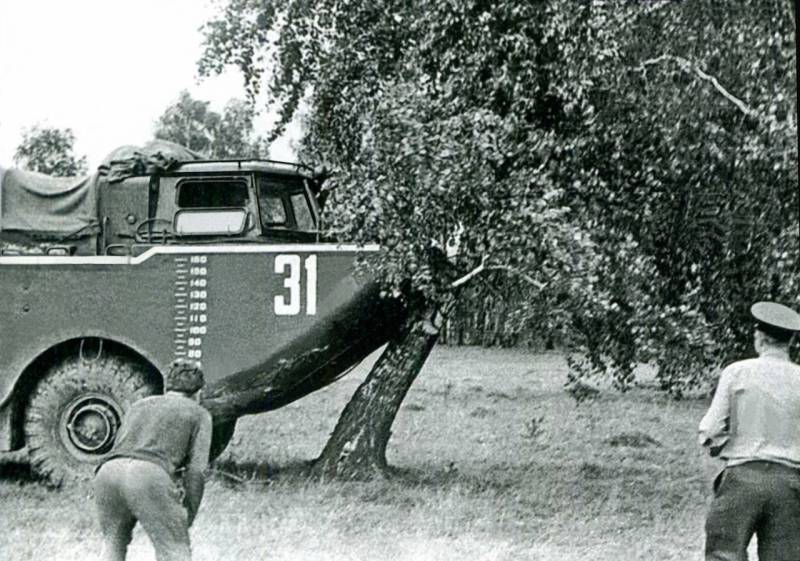
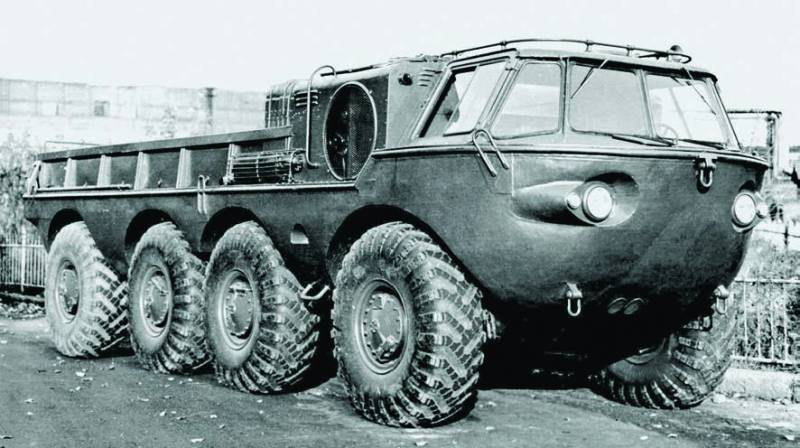
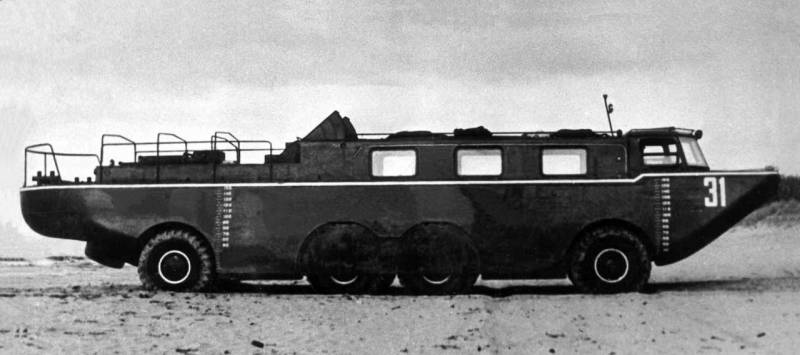
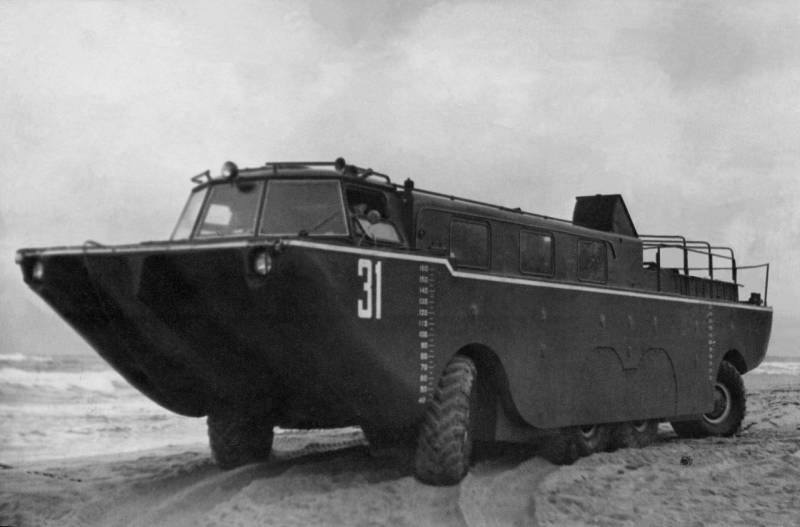
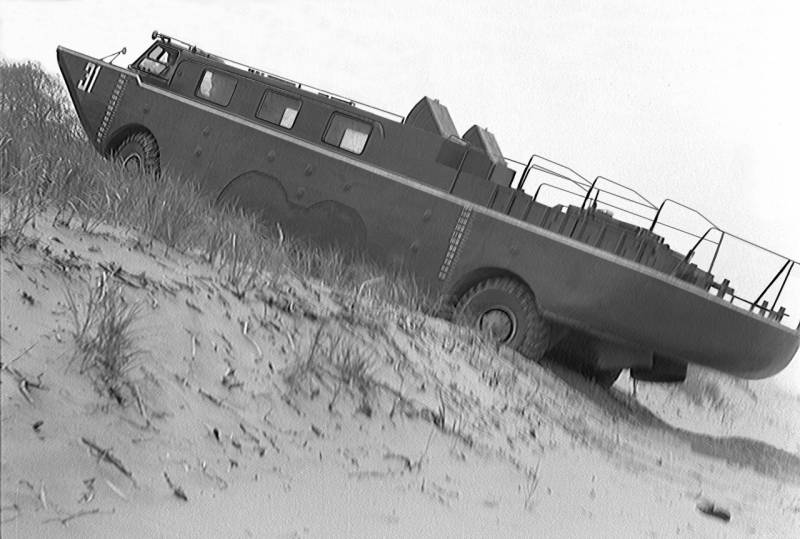
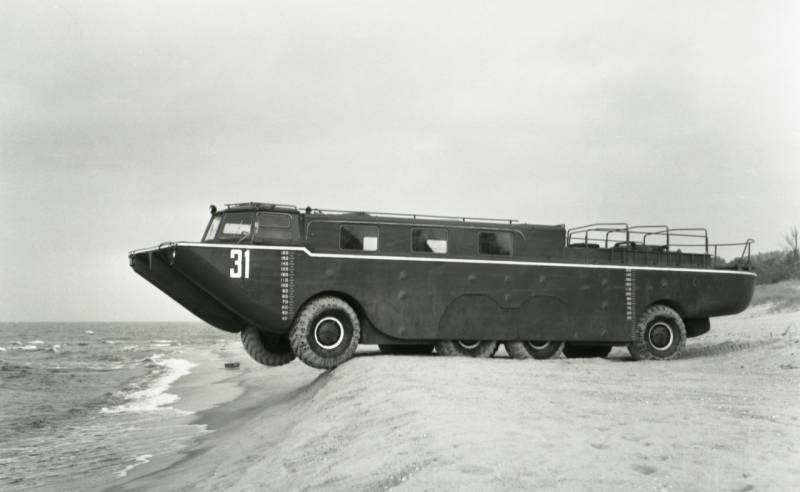
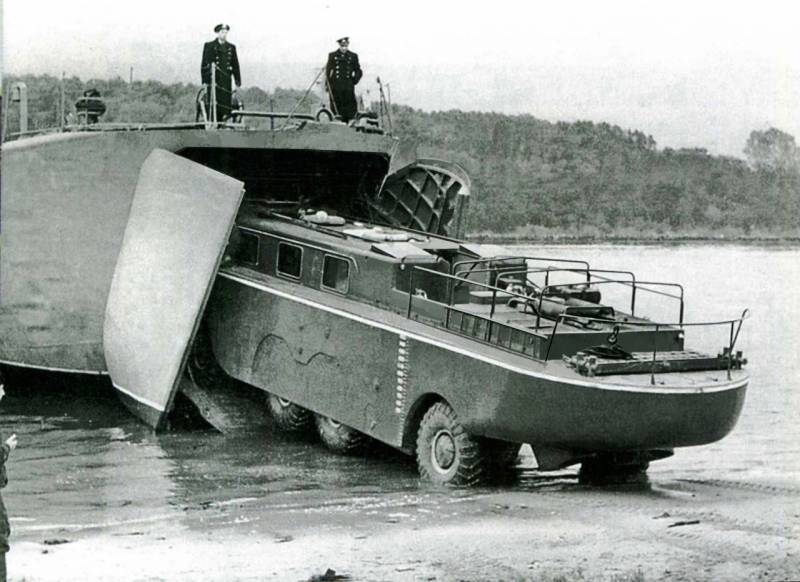
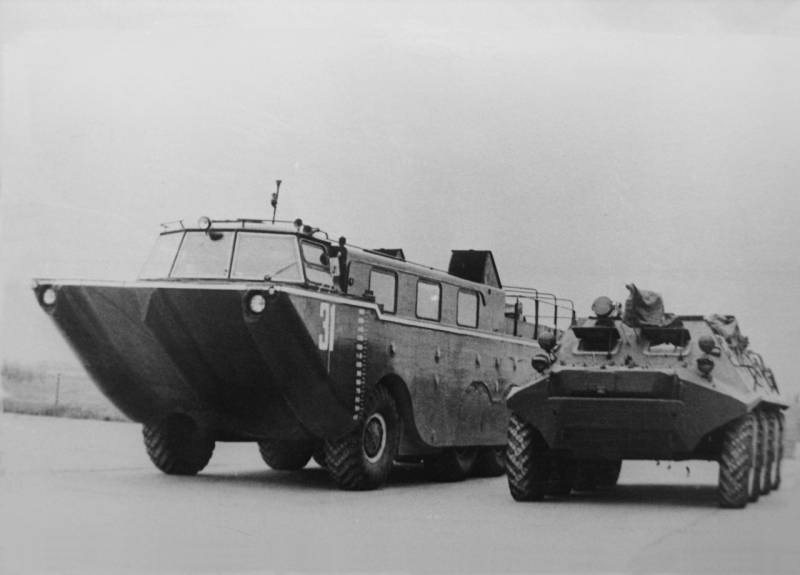
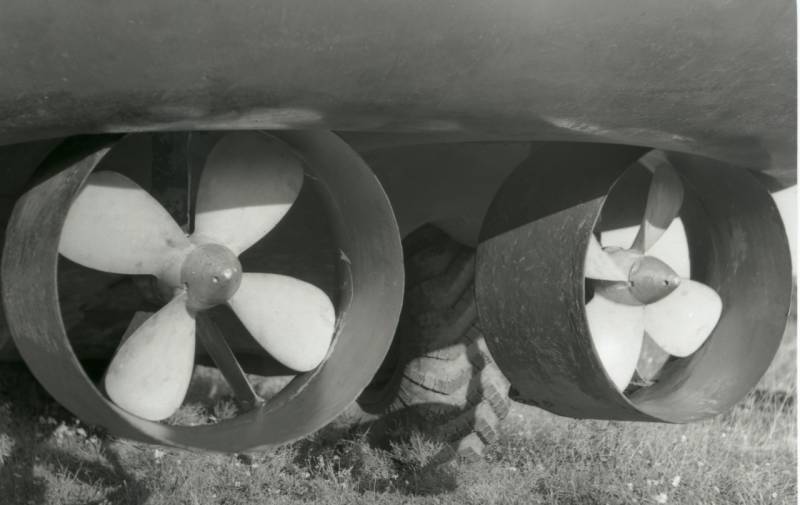
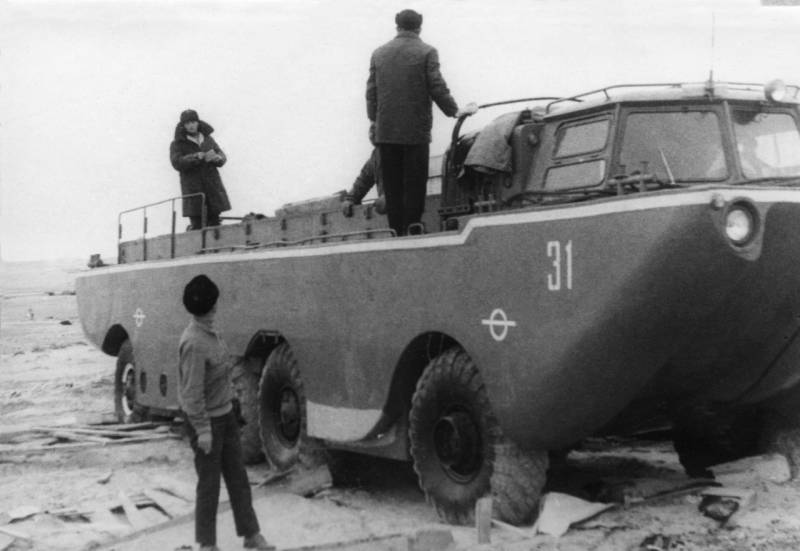
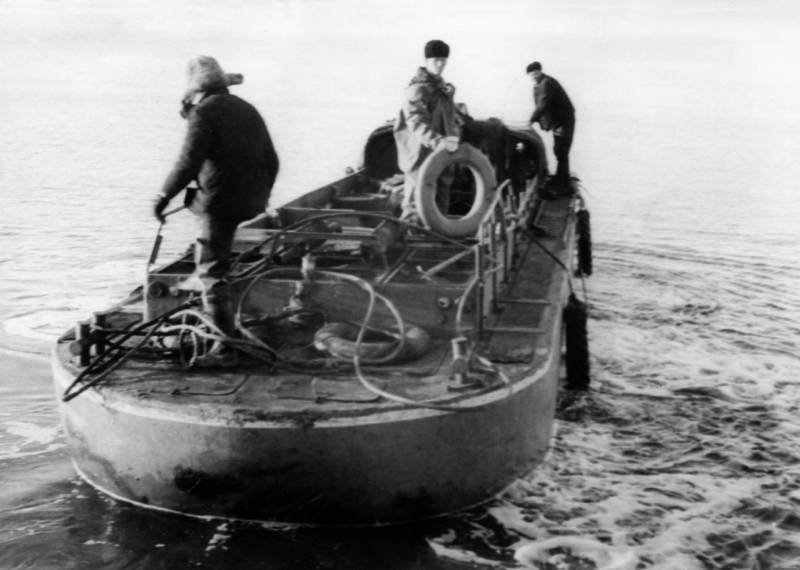
Information